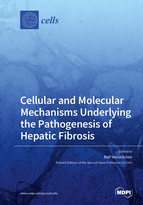Cellular and Molecular Mechanisms Underlying the Pathogenesis of Hepatic Fibrosis
A special issue of Cells (ISSN 2073-4409). This special issue belongs to the section "Cellular Pathology".
Deadline for manuscript submissions: closed (30 September 2019) | Viewed by 332183
Special Issue Editor
Interests: liver diseases; biomakrer; cellular signaling; cytokines; chemokines; food products; vitamin A; weight loss; diet; fats; carbohydrates; supplements
Special Issues, Collections and Topics in MDPI journals
Special Issue Information
Dear Colleagues,
The hallmark of hepatic fibrosis is the formation and deposition of excess fibrous connective tissue, leading to progressive architectural tissue remodelling. Irrespective of the underlying pathogenic cause (e.g. genetic disorders, viruses, alcohol, autoimmune attacks, metabolic disorders, cholestasis, venous obstruction, parasites), tissue damage induces an inflammatory response involving the local vascular system and the immune system and a systemic mobilization of endocrine and neurological mediators, ultimately leading to the activation of matrix-producing cell populations. In addition, excess fat and other lipotoxic mediators provoking endoplasmic reticulum stress, the alteration of mitochondrial function, oxidative stress, and modifications in the microbiota are associated with non-alcoholic fatty liver disease and, subsequently, the initiation and/or progression of hepatic fibrosis.
In this Special Issue of Cells, I invite you to contribute, either in the form of original research articles, reviews, or shorter perspective articles on all aspects related to the theme of “Cellular and Molecular Mechanisms Underlying the Pathogenesis of Hepatic Fibrosis”. Expert articles describing mechanistic, functional, cellular, biochemical, or general aspects of hepatic fibrogenesis are highly welcome. Relevant topics include, but are not limited to
- Cytokine signaling
- Chemokine function
- In vitro and in vivo models
- Immunology in hepatic fibrosis
- Extracellular matrix
- Inflammation
- Fibrosis
- NASH/NAFLD
- Alcohol
- Hepatitis
- Microbiota
- Bioimaging
- Translational medicine
Prof. Ralf Weiskirchen
Guest Editor
Manuscript Submission Information
Manuscripts should be submitted online at www.mdpi.com by registering and logging in to this website. Once you are registered, click here to go to the submission form. Manuscripts can be submitted until the deadline. All submissions that pass pre-check are peer-reviewed. Accepted papers will be published continuously in the journal (as soon as accepted) and will be listed together on the special issue website. Research articles, review articles as well as short communications are invited. For planned papers, a title and short abstract (about 100 words) can be sent to the Editorial Office for announcement on this website.
Submitted manuscripts should not have been published previously, nor be under consideration for publication elsewhere (except conference proceedings papers). All manuscripts are thoroughly refereed through a single-blind peer-review process. A guide for authors and other relevant information for submission of manuscripts is available on the Instructions for Authors page. Cells is an international peer-reviewed open access semimonthly journal published by MDPI.
Please visit the Instructions for Authors page before submitting a manuscript. The Article Processing Charge (APC) for publication in this open access journal is 2700 CHF (Swiss Francs). Submitted papers should be well formatted and use good English. Authors may use MDPI's English editing service prior to publication or during author revisions.







